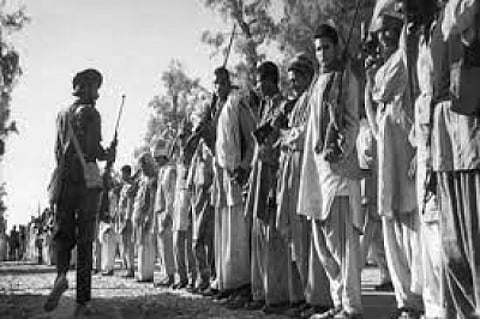
- Home
- न्यूजग्राम
- India
- World
- Politics
- Entertainment
- Culture
- Lifestyle
- Economy
- Sports
- Sp. Coverage
- Misc.
- NewsGram Exclusive
- Jobs / Internships

The genesis of the "dispute" of Kashmir is also the story of India's Independence from colonialism and how in the last stages of leaving India the Brits in collaboration with the Muslim League carved out Pakistan in the West and East Pakistan (now Bangladesh).
Kashmir's Muslim majority region, ruled by a Dogra Maharaja, an unpalatable fact for the elite Punjabi Muslims propounding the two-nation theory, became the unfinished business of Partition for the next 70-plus years. Operation Gulmarg became the first of those "bleeding India with a thousand cuts" policies, the logistics of which have been described by none other than Major-General Akbar Khan in his book 'Raiders in Kashmir'.
The tribal 'lashkars' were exactly that - raiders - looting, killing, pillaging, and assaulting the women of Kashmir irrespective of their religion, caste, and creed in the Poonch and Sialkot area of Jammu.
The looting was paradoxically also the reason why Srinagar did not fall to them and gave enough time for the Maharaja to ask India for help and accede to the newly formed Republic of India. Tales of valor about defending Srinagar by the J&K Infantry headed by Major Somnath Sharma and the feats of Brigadier Rajinder Singh are enshrined in the war memorials dotting the landscape. So are the gallant roles that volunteer forces of men and women played during the tumultuous times, what became known as the Jammu & Kashmir National Militia.
The destruction wrought by the 'lashkar' militia, especially from the Afridi clan is best described in Andrew Whitehead's book 'A Mission in Kashmir'. The 'sacking of Baramulla' as it is known locally involved the raping and looting of Kashmiri families across Baramulla as the lashkars made their way towards the summer capital Srinagar.
Andrew Whitehead, a BBC correspondent, puts the lives and tribulations of the members of a Missionary hospital in Baramulla as the focal point of his book, recounting the events around October 22 and later culminating in the Accession of Kashmir to India. The brutal murders of a retired British officer Colonel Dyke and his pregnant wife along with a few of the mission's nuns are still recalled by locals who survived the carnage.
Kashmiri octogenarians retell the tales of those dark days of October when lashkar militias comprising Pashtun tribesmen crossed the borders of the kingdom of J&K while its Maharaja was dealing with the rebellion at Poonch. The riyasat of J&K was wavering in signing its accession to either India or Pakistan, with the National Conference under Sheikh Abdullah weighing in with the Indian National Congress and the Jamaat elements of Poonch and other areas throwing their loyalty with the "invited" raiders for merger with Pakistan. Pakistan's government also imposed an economic blockade in violation of the standstill agreement, that Hari Singh had offered to enter with both the dominions, to pressurize him.
As the news of the raids reached Srinagar, a WSDC, the women's wing of Jammu & Kashmir National Militia, was raised to repel the tribals should they reach Srinagar. It provided a common platform that brought together Kashmiri women from different religions, castes, classes, and educational backgrounds to serve the common mission of defending their honor and dignity, by bearing arms. Maharani Tarabai can be seen in photographs of that era, personally supervising the training of girls and women.
Zooni Gujjar, a Muslim woman from a non-privileged background who was a renowned activist in the National Conference, became the face of this indigenous resistance against the Pakistani invaders on Kashmir Defends Democracy, a pamphlet produced in 1948 in support of Sheikh Abdullah and Kashmir's accession to India.
The public display of Kashmiri women carrying rifles was an emphatic demonstration that the era of princely rule was over. A contingent of militia members was inspected by Nehru, India's prime minister when he visited the Kashmir Valley. The popular political mobilization of which the women's militia was part has been largely written out of the competing historical narratives in Kashmir. Pakistan doesn't want to be reminded of a time when Kashmiris mustered in support of Indian rule; and Kashmiri separatists, many now advocates of independence, are uncomfortable being reminded that seventy years ago Kashmiris took to the streets and parade grounds to support accession to India. (KB/IANS)
